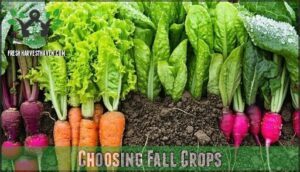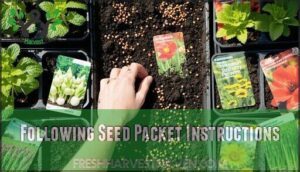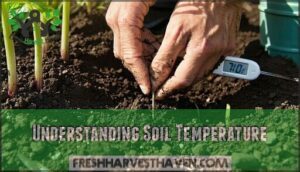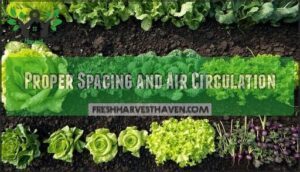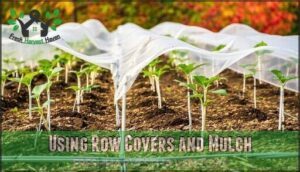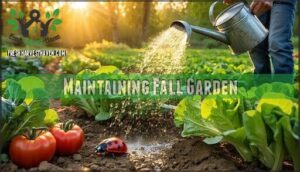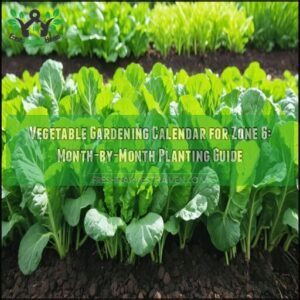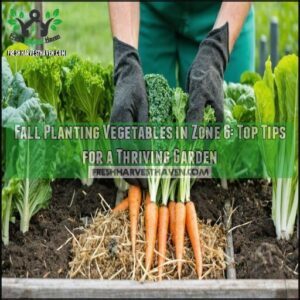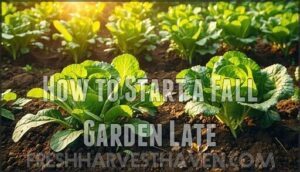This site is supported by our readers. We may earn a commission, at no cost to you, if you purchase through links.
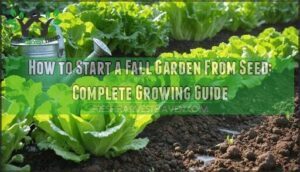 Learning how to start a fall garden from seed begins with timing your planting around your area’s first frost date.
Learning how to start a fall garden from seed begins with timing your planting around your area’s first frost date.
You’ll count backwards from this date, giving yourself enough growing time for your chosen crops.
Start with cool-season vegetables like lettuce, radishes, and kale that actually prefer cooler temperatures.
Clear out spent summer plants, add fresh compost to replenish tired soil, and plant seeds in late July through early September.
Keep the soil consistently moist since germination can be trickier in summer heat.
Fall gardens often surprise gardeners with their productivity and flavor, especially once those first light frosts hit.
Table Of Contents
- Key Takeaways
- Preparing Fall Garden
- Starting Fall Garden Seeds
- Choosing Fall Crops
- Planting Fall Seeds
- Maintaining Fall Garden
- Frequently Asked Questions (FAQs)
- How do I plan what to plant in my Fall Garden?
- How do I start a fall garden vegetable garden?
- When should I plant flower seeds?
- Can you plant vegetable seeds in the fall?
- When should I plant all my fall crops?
- Is it time to start fall seeds?
- When should I start seeds for a fall garden?
- How late can you plant a fall garden?
- How to start a fall vegetable garden?
- How do you prepare ground for fall planting?
- Conclusion
Key Takeaways
- Time your planting by counting backwards from your first frost date – You’ll need to give cool-season crops like lettuce, radishes, and kale enough time to mature, typically planting 8-18 weeks before frost hits.
- Prepare your soil properly before planting – Clear out spent summer plants, add 2-3 inches of fresh compost, and mix in organic amendments like kelp meal to create nutrient-rich growing conditions.
- Focus on cold-hardy vegetables that thrive in cooler weather – Choose crops like spinach, carrots, and Brussels sprouts that actually taste sweeter after light frost and can handle temperature drops.
- Keep seeds consistently moist and use protection methods – Water regularly during hot summer planting periods and use row covers or cold frames to extend your growing season and protect plants from unexpected weather changes.
Preparing Fall Garden
Before you can plant your fall seeds, you’ll need to clear out tired summer crops and refresh your garden beds with fresh compost and organic matter.
This preparation step creates the nutrient-rich foundation your cool-season vegetables need to thrive during shorter autumn days, which is essential for their growth and development, and helps them to establish a strong root system, making them more resilient.
Fall garden preparation transforms tired summer soil into a powerhouse foundation that fuels resilient cool-season crops.
Clearing Summer Crops
Pull out tired summer plants to kick off your garden preparation. Crop removal means yanking spent tomatoes, peppers, and beans from their roots. For stubborn stems, cut at soil level instead.
This garden cleanup prevents pests from overwintering in old foliage. Toss diseased plants in the trash—never your compost pile.
Healthy plant material makes excellent composting options for next season’s soil preparation.
Adding Compost and Kelp
Once you’ve cleared your summer crops, it’s time to feed your soil. Think of compost and kelp as a hearty meal for hungry earth. These sustainable amendments transform tired soil into a nutrient powerhouse that’ll make your fall seeds sing.
Mix 2-3 inches of compost throughout your planting area, then sprinkle dried kelp for those trace minerals your plants crave. Water everything with compost tea to kickstart beneficial microbes. To easily buy garden compost, consider online retailers.
Here’s your soil enrichment checklist:
- Add compost at 2-3 inches deep for ideal soil preparation
- Apply kelp nutrients generously across planting beds
- Create compost tea by steeping compost overnight
- Layer organic matter on top as protective mulch
- Allow soil amendments to settle 1-2 weeks before planting
Your fall garden will thank you with robust growth.
Replenishing Soil Amendments
Three key soil amendments will supercharge your fall garden’s potential beyond basic compost application. After your initial soil feeding, targeted amendments address specific deficiencies that soil testing reveals. Think of it as fine-tuning your garden’s nutrition plan.
Think of soil amendments as vitamins for your garden—each one targets exactly what your plants are craving.
Bone meal is a popular choice, and you can find it easily to enhance your soil. Smart soil preparation for fall means understanding kelp benefits work alongside these amendments. You’ll notice stronger seedlings and better harvests when your soil amendments create the perfect foundation for fall garden preparation success.
Removing Grass and Weeds
Since weeds can steal nutrients from your fall garden seeds, thorough weed identification is your first step in fall garden preparation. Manual removal works best for starting fall garden success.
Here’s your soil preparation fall action plan:
- Pull weeds by their roots using a garden fork
- Apply herbicide options for persistent perennials if needed
- Try soil solarization with clear plastic for stubborn patches
- Remove all grass clumps completely
- Implement preventative measures like mulching after fall garden planning
Removing old plants is essential, as it helps prevent pests and diseases.
Starting Fall Garden Seeds
Starting your fall garden seeds indoors gives you a head start on the season’s cooler weather. Begin seed starting 6-8 weeks before your first expected frost date. You’ll find your local frost dates by checking weather websites or agricultural extension resources.
Choose fall garden seeds from regional seed sources for varieties that thrive in your climate. Quality matters more than quantity when selecting seeds for fall garden planning.
Fill seed-starting trays with seed starting mix – it’s lighter and drains better than regular potting soil. Plant seeds at the depth listed on packets, typically 2-3 times the seed’s width.
Indoor germination tips include maintaining 65-75°F soil temperature and consistent moisture. You can also leverage the warmer soil temperature for quicker germination. Place trays under grow lights or in bright windows.
Transplanting seedlings comes after seedling hardening off – gradually exposing them to outdoor conditions over 7-10 days. This prevents transplant shock. Direct sowing fall crops works too, but indoor starting extends your growing season and improves success rates.
Choosing Fall Crops
You’ll want to select vegetables that can handle cooler temperatures and mature quickly before your first hard frost arrives.
Focus on cold-hardy crops like lettuce, radishes, and spinach that actually taste sweeter after experiencing light frost, along with slower-growing root vegetables like carrots and beets that’ll reward your patience with exceptional fall flavor.
Cold-Tolerant Vegetables
When selecting vegetables for your autumn garden, cold-tolerant vegetables become your best allies for extending the growing season. These frost-hardy varieties actually improve in flavor after experiencing light frosts, making them perfect for fall harvest extension.
Considering which varieties can withstand specific temperatures is key, so researching winter-kill temperatures is worthwhile.
Your top choices for successful overwintering techniques include:
- Kale – survives temperatures down to 0°F and becomes sweeter after frost
- Brussels sprouts – develops rich, nutty flavors in cool weather conditions
- Spinach – thrives in cold frame gardening setups for winter harvests.
These zone-specific crops reward patient gardeners with fresh produce throughout the colder months.
Fast-Maturing Crops
When time’s running short, fast-maturing crops become your fall garden’s secret weapon.
Radish varieties sprout in just 25 days, while lettuce options and arugula growth deliver fresh salad greens within 45 days.
Spinach harvest thrives in cool weather, and mache cultivation provides gourmet greens.
These fall vegetable seeds maximize your seed starting success before winter’s arrival.
Consider planting crops with high garden productivity to maximize your harvest.
Root Crops and Greens
Root crops and greens transform your fall garden into a treasure trove of Cool Weather Sweetness. These cool season crops actually improve in flavor after frost kisses them.
Plant fall vegetable seeds like carrots, beets, and parsnips for that signature sweetness boost. Overwintering Greens such as kale and spinach handle freezing temperatures like champions.
Radishes deliver a Fast Radish Harvest in just 25 days – perfect for impatient gardeners! Consider Fall Crop Rotation and check Soil pH Balance before seed starting.
These hardy vegetables reward your patience with incredible flavor and nutrition.
Suitable Flowers for Fall
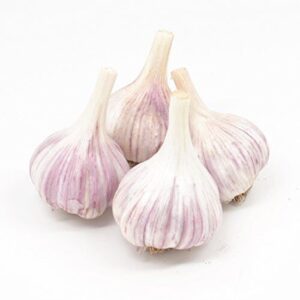 View On Amazon
View On Amazon
Beyond root vegetables and leafy greens, fall flowers transform your garden into a colorful haven.
- Pansies – Vibrant flower colors that handle light frosts beautifully
- Calendula – Cheerful orange blooms perfect for companion planting
- Snapdragons – Tall spikes that add vertical interest
- Nasturtiums – Fast-growing fall bloomers with edible petals
Planting Fall Seeds
You’ll find that planting fall seeds requires careful attention to timing and technique, since cooler temperatures and shorter days create different growing conditions than spring planting.
The key is following seed packet instructions while adjusting for your local soil temperature and frost dates, which helps guarantee your seeds germinate properly before winter arrives.
Following Seed Packet Instructions
When you’re ready to plant, treat your seed packets like treasure maps—they hold the secrets to successful germination.
Each packet reveals vital details: sowing depth, watering needs, sunlight requirements, and maturity dates. Some seeds crave darkness while others need light exposure.
Follow the planting guide precisely for maximum seed viability. Your seed starting success depends on respecting these specific instructions during seed sowing.
Understanding Soil Temperature
While your soil thermometer reveals the truth about germination temperature, most fall seeds need soil warmth between 60-75°F to germinate successfully.
Here’s your temperature considerations checklist:
- Measure soil warmth 2 inches deep each morning
- Wait for consistent readings across three days
- Consider mulch effects on soil warming patterns
- Adjust seed sowing depth based on climate impact for ideal root development
Proper Spacing and Air Circulation
When spacing your fall seeds, think of it as giving each plant its own breathing room—literally.
Thoughtful spacing transforms a crowded garden patch into a thriving ecosystem where each plant can reach its full potential.
Spacing Benefits include healthier plants and easier maintenance. Overcrowding Risks lead to competition for nutrients and sunlight.
Follow seed packet instructions for proper distances during seed starting.
| Plant Type | Spacing Distance | Airflow Benefits |
|---|---|---|
| Lettuce | 4-6 inches | Prevents leaf rot |
| Radishes | 2-3 inches | Reduces fungal issues |
| Carrots | 2-4 inches | Promotes root development |
| Spinach | 3-5 inches | Minimizes disease spread |
Airflow Methods through proper garden planning guarantee Disease Prevention.
Thin seedlings after seed germination to achieve ideal Plant Size and garden organization.
Using Row Covers and Mulch
Your fall garden needs protection from unpredictable weather shifts. Row covers act like a cozy blanket, shielding plants from frost while letting sunlight through. Meanwhile, mulch works underground, insulating soil and locking in moisture.
Together, they’re your secret weapons for temperature regulation and extending the growing season. To guarantee healthy growth, remember to review adjusting planting times for fall crops.
- Choose lightweight fabric row cover materials for breathability and easy plant access
- Apply organic mulch types like straw, shredded leaves, or grass clippings around plants
- Use row covers for frost protection during unexpected cold weather dips
- Maintain water retention with 2-3 inches of mulch around plant bases
- Combine both methods for thorough pest protection and season extension
Maintaining Fall Garden
Once you’ve planted your fall seeds, you’ll need to stay on top of watering, pest control, and season extension techniques to keep your garden thriving through cooler months.
Your fall crops depend on consistent care and smart protection strategies to produce the best harvest before winter arrives.
Consistent Watering and Soil Moisture
Your fall seeds crave consistent moisture like a steady heartbeat. Check soil moisture by pressing your finger an inch deep—if it’s dry, water thoroughly.
Mulch benefits include locking in moisture and stabilizing temperature for ideal seed germination.
During dry spells, deep watering frequency beats shallow sprinkles, encouraging strong roots. This smart approach helps seeds germinate successfully while conserving water across different soil types.
Monitoring for Pests and Weeds
Your fall garden faces fewer pests and fewer weeds than summer crops, but don’t skip your weekly patrol.
Pest identification becomes easier with cooler weather bringing predictable visitors. Pull emerging weed seeds before they spread, and encourage beneficial insects like ladybugs.
Simple organic solutions and preventative measures keep garden maintenance minimal while protecting your harvest through weed control.
Tilling soil in the fall can help with disrupting insect life.
Extending The Growing Season
After keeping pests at bay, you’ll want to squeeze every last tomato and lettuce leaf from your fall garden. The first frost doesn’t mean game over—it’s just halftime.
Frost Protection becomes your secret weapon for Season Extension. Row covers act like cozy blankets, trapping heat and creating a warmer microclimate around your Cold Weather Crops. Consider using specialized garden covers to protect your plants.
Install mini hoop tunnels using PVC pipes and plastic sheeting for bulletproof protection. Cold Frames—essentially bottomless boxes with transparent tops—shield plants from harsh weather while letting sunlight through.
Smart Crop Rotation and succession planting keep harvests rolling. Sow fast-maturing crops every 2-3 weeks for continuous production. Some Overwintering Crops like kale actually taste sweeter after frost exposure.
Here are proven Fall Garden Tips for extending growing season:
- Use thermal mass objects like water-filled containers to store daytime heat
- Position gardens in maximum sun exposure areas with wind protection
- Apply dark mulch to absorb solar radiation and warm soil
- Consider portable greenhouse structures for 4-6 additional growing weeks
Harvesting and Enjoying Fall Crops
Now that you’ve protected your fall crops, it’s time to reap what you’ve sown.
Harvest season brings unique rewards that make all your hard work worthwhile.
Pick your fall harvest vegetables in the morning when they’re crisp and moisture-rich.
Frost-sweetened flavors make root crops like carrots and beets taste incredibly sweet after light frost hits.
Proper fall crop storage in cool, dry places preserves freshness.
Create seasonal recipes and garden-to-table meals while sharing fall bounty with neighbors.
Frequently Asked Questions (FAQs)
How do I plan what to plant in my Fall Garden?
Like a town crier announcing harvest time, you’ll count backward from your first frost date.
Choose cold-hardy crops with shorter maturity periods.
Mix quick-growing radishes with slower root vegetables for diverse harvests.
How do I start a fall garden vegetable garden?
Clear your summer crops and prepare beds with compost.
Start cold-hardy varieties like lettuce, radishes, and broccoli 8-12 weeks before your first frost.
Keep seeds consistently watered and use row covers for protection.
When should I plant flower seeds?
The early bird catches the worm," and you’ll catch stunning blooms by planting flower seeds in late summer through early fall.
Most annuals need 6-8 weeks before your first frost date for proper establishment.
Can you plant vegetable seeds in the fall?
Yes, you can plant vegetable seeds in fall! Choose cold-hardy crops like lettuce, radishes, and spinach. Plant 9-15 weeks before your first frost date for best results.
When should I plant all my fall crops?
You’ll want to count backward from your first fall frost date to determine planting times.
Most fall crops need 8-18 weeks before frost, so start planning in mid-summer for best results.
Is it time to start fall seeds?
Right now in mid-June, you’re perfectly positioned to start fall seeds.
Begin with cool-season crops like broccoli and lettuce indoors, then move to direct sowing beans and radishes in late summer for ideal harvest timing.
When should I start seeds for a fall garden?
Timing’s everything when fall gardening calls! Start your seeds 8-18 weeks before your first frost date. Count backward from that date, considering each crop’s maturity time for perfect harvest timing.
How late can you plant a fall garden?
You can plant fall gardens surprisingly late – even into November or December in temperate zones.
The key is choosing quick-maturing crops like radishes and lettuce that’ll beat your first hard frost.
How to start a fall vegetable garden?
Like seeds of hope in autumn’s embrace, you’ll clear spent summer crops first.
Next, prepare beds with compost, then calculate planting dates by counting backward from your area’s first frost date.
How do you prepare ground for fall planting?
Clear spent summer crops completely, then enrich your soil with fresh compost and organic matter like kelp meal.
Water the prepared bed thoroughly and let it settle for a few days before sowing your fall seeds.
Conclusion
Starting your autumn harvest adventure doesn’t have to feel overwhelming when you break it down step by step.
You’ve learned how to start a fall garden from seed by timing plantings around frost dates, preparing nutrient-rich soil, and selecting cold-hardy varieties.
Remember to keep seeds consistently moist during those hot summer planting days, and don’t forget row covers for protection.
Your fall garden will reward you with sweeter vegetables and extended harvests well into winter months.
- https://wayne.ces.ncsu.edu/2022/08/time-to-plant-a-fall-vegetable-garden/
- https://extension.unh.edu/resource/starting-plants-seed-fact-sheet
- https://extension.uga.edu/publications/detail.html?number=C1258&title=fall-vegetable-gardening
- https://www.thespruce.com/how-to-start-a-garden-from-scratch-2132778
- https://fromsoiltosoul.ca/complete-raised-bed-gardening-guide-for-beginners/

